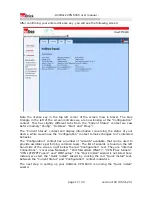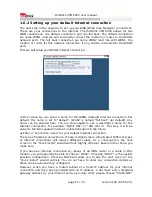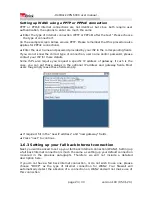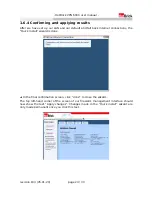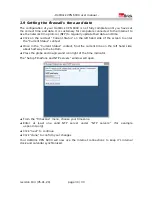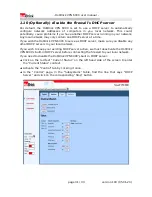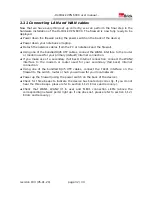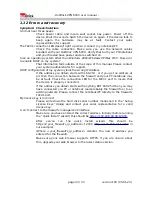
- HotBrick VPN 6000 user manual -
connections (WAN or Wide Area Network connections) and your local network (or
LAN).
The “Quick Install” wizard will allow you to enter network settings specific to your local
network. First we enter a label to use for the local network. Default setting is “lan”,
which seems sensible. In more complex network environments, with more than one
LAN you may opt to use a more descriptive name (like “public lan” or “accounting lan”
instead). In any case, make sure the names you use are unique throughout your
organization, to avoid confusion arising from identical network names for different
networks.
➔
Enter a network name for your local network
The next values to enter are an internal IP Address for the firewall (in the context of
the LAN) and a net mask. Together, the IP Address and the net mask define a network
address for the local network. In our example we use an IP Address of 192.168.0.1,
with a net mask of 24 (bits). A net mask of 24 (=3*8) means that the first three
numbers from the IP Address will be part of the network address, so all addresses in
the network start with 192.168.0. If you already have a local network, then this
network address should have a predefined value (if uncertain, contact your network
administrator). In this case, please note that HotBrick VPN 6000 displays the net mask
as a number of bits, not in the 255.255.255.0 format.
If you do not have a local network, then you need to pick an address for your local
network first. There are a number of possible network addresses set aside for use in a
local network. The table below lists the possible IP addresses, their net masks and
uses:
Firewall IP address Net mask
Network Address
Internal IP
addresses
maximum
addresses
192.168.x.z
24
192.168.x.0
192.168.x.n
254
172.16.x.z
24
172.16.x.0
192.168.x.n
254
10.x.y.z
8
10.0.0.0
10.n.m.p
16 million
Where x, y can denote any
predefined
number between 0 and 255, z can denote any predefined number
between 1 and 254, while n, m and p may be any number between 1 and 254.
Generally, a local network does not need over 254 IP addresses (per distinct local
network). We would therefore recommend you choose a 192.168.x or 172.16.x
network.
Users who intend to use the HotBrick VPN 6000 to connect their local network to
another LAN by means of a VPN tunnel (or indeed, anyone wishing to leave this option
open) will do well to choose a different network address for each LAN (for example
192.168.0.0, 192.168.1.0, 192.168.2.0 etc.).
page 19 / 33
version 193 (05-01-20)
Содержание VPN 6000
Страница 1: ...HotBrick VPN 6000 user manual version 193 2005 01 20 ...
Страница 3: ......













